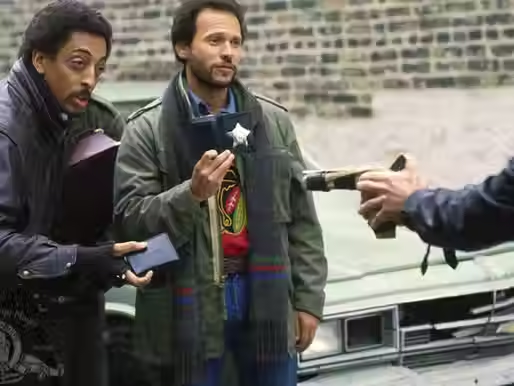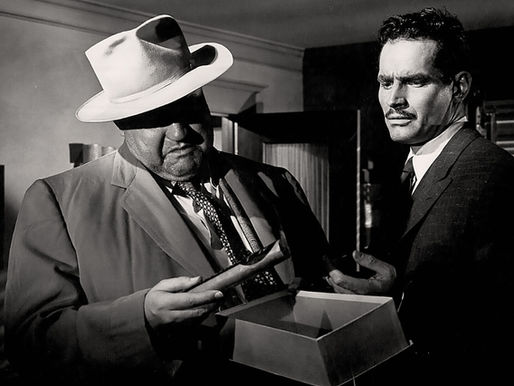top of page
Search
Crime / Mystery
Classic Crime / Mystery Films from 1930 - 1999


On the Waterfront (1954)
On the Waterfront is one of the most powerful and influential American films of the 20th century. Directed by Elia Kazan and released in 1954, it combines social realism with emotional intensity to explore corruption, conscience, and redemption. Its story, based on real events surrounding longshoreman union corruption on the New York and New Jersey docks, speaks to both its era and timeless human dilemmas.

Soames Inscker
5 min read


The Thin Man Goes Home (1945)
The Thin Man Comes Home (1945) is the fifth film in the beloved Thin Man series starring William Powell and Myrna Loy as the suave, quick-witted husband-and-wife detective duo, Nick and Nora Charles. Released by MGM during the final years of World War II, this entry diverges slightly from the glamorous, urban settings of earlier films by taking the Charleses to Nick’s hometown for a rare domestic twist on the established formula.

Soames Inscker
5 min read


Witness for the Prosecution (1957)
Witness for the Prosecution (1957) is a dazzling courtroom drama that masterfully blends suspense, wit, and character study, all under the brilliant direction of Billy Wilder. Adapted from Agatha Christie's celebrated stage play, the film stars Charles Laughton, Marlene Dietrich, and Tyrone Power in a narrative filled with sharp turns, biting dialogue, and one of the most memorable twist endings in cinema history.

Soames Inscker
5 min read


Shadow of the Thin Man (1941)
William Powell and Myrna Loy once again prove why they were one of Hollywood’s most beloved screen pairs. Powell’s Nick Charles is still suave, debonair, and quick-witted—his charm only deepened by a paternal streak that adds warmth to the character. Loy's Nora is as elegant and sharp as ever, serving as Nick’s partner in both life and sleuthing. Their on-screen relationship is a perfect marriage of equals—sophisticated yet playful—and remains a high point of the series.

Soames Inscker
4 min read


Another Thin Man (1939)
With a fresh setting, a new ensemble of suspects, and a charming addition to the Charles family in the form of their infant son, Another Thin Man offers a delightful blend of mystery, comedy, and domestic hijinks. Though some critics view it as a softer installment than its predecessors, the film remains a thoroughly enjoyable chapter in one of cinema’s most stylish detective franchises.

Soames Inscker
5 min read


After The Thin Man (1936)
After the Thin Man (1936) is the sparkling sequel to the smash hit The Thin Man (1934), and it reunites William Powell and Myrna Loy as Nick and Nora Charles, cinema’s most stylish and witty detective couple.

Soames Inscker
4 min read


Revenge of the Pink Panther (1978)
Revenge of the Pink Panther (1978) is the fifth and final Pink Panther film to be released during Peter Sellers' lifetime, and the last of the series made before his death in 1980. Directed once again by Blake Edwards, the film continues the comic misadventures of the eternally clumsy Inspector Jacques Clouseau, this time embroiled in a plot involving the French underworld, international intrigue, and mistaken death.

Soames Inscker
4 min read


Running Scared (1986)
Released in 1986, Running Scared is a quintessential 1980s buddy-cop action-comedy that blends sharp dialogue, charismatic leads, and brisk pacing with an emotional core that's rare for the genre. Directed by Peter Hyams (Capricorn One, 2010), the film pairs Billy Crystal and Gregory Hines as two wisecracking Chicago cops on the brink of retirement who are forced back into action when a drug lord they've been chasing resurfaces.

Soames Inscker
4 min read


M (1931)
Fritz Lang’s M (1931) is widely regarded as one of the greatest and most influential films ever made. A chilling hybrid of crime thriller, social drama, and proto-noir, it was Lang’s first sound film and remains his masterpiece.

Soames Inscker
5 min read


Touch of Evil (1958)
Orson Welles’s Touch of Evil (1958) is widely regarded as the last true film noir of Hollywood’s classic era—and arguably one of the greatest. It’s a feverish, atmospheric, and at times grotesque crime drama, brimming with visual invention and moral ambiguity. Made on a modest budget and dismissed by its studio, the film was re-edited and truncated before its release, only to be rediscovered and reappraised decades later.

Soames Inscker
5 min read


The Killing (1956)
Stanley Kubrick’s The Killing (1956) is widely considered one of the most influential crime films of its era—and justly so. A taut, razor-sharp noir thriller that crackles with intensity and precision, it marked Kubrick’s first mature work and set the tone for his meticulous, often clinical approach to storytelling. Adapted from Lionel White’s novel Clean Break, The Killing is both a triumph of narrative innovation and an exemplary piece of low-budget filmmaking that has cast

Soames Inscker
4 min read


Blow Up (1966)
Michelangelo Antonioni’s Blow-Up (1966) is a landmark of 1960s cinema—a work that simultaneously captures the cultural and aesthetic energy of Swinging London and interrogates the very nature of reality, perception, and meaning. It was Antonioni’s first English-language film, and perhaps his most internationally influential, earning the Palme d’Or at Cannes and launching a new era of art cinema into the mainstream.

Soames Inscker
5 min read


The Vanishing (1988)
The Vanishing (Spoorloos, 1988), directed by George Sluizer, is a psychological thriller that unnerves not through action or gore, but through its cold, clinical exploration of obsession, evil, and the terrifying ambiguity of disappearance. A Dutch-French production based on the novella The Golden Egg by Tim Krabbé, the film is a stark, tightly wound meditation on the unknown—and on the monstrous banality of evil.

Soames Inscker
5 min read


The Long Goodbye (1973)
Robert Altman’s The Long Goodbye (1973) is less a traditional adaptation of Raymond Chandler’s 1953 detective novel than a postmodern riff on it—a revisionist noir, a sun-drenched elegy for the hardboiled genre, and a sly, satirical portrait of 1970s Los Angeles in moral and cultural freefall.

Soames Inscker
5 min read


Point Blank (1967)
Point Blank (1967) is a film of shattered time, splintered identity, and existential revenge. Directed by the visionary John Boorman in his first American production, it takes the skeletal framework of a pulp crime thriller and transforms it into a hypnotic, existential, and almost surrealist neo-noir.

Soames Inscker
5 min read


Elevator to the Gallows (1958)
Louis Malle’s Elevator to the Gallows (Ascenseur pour l’échafaud) is a landmark of postwar French cinema—a taut, stylish thriller that bridges the fatalism of American film noir with the existential anxiety and aesthetic innovation of the French New Wave. Released in 1958, when Malle was only 24 years old, the film marked both his feature debut and the beginning of a long, varied, and daring directorial career.

Soames Inscker
5 min read


Shadow of Doubt (1943)
Shadow of a Doubt (1943) is often described by Alfred Hitchcock himself as his personal favourite among all his films—and with good reason. In many ways, it’s one of his most psychologically disturbing works, despite lacking the overt violence or technical bravura of his later classics. This slow-burning thriller unfolds in broad daylight, on the sunny porches and quiet streets of small-town America, making its themes of corruption, duality, and evil all the more unsettling.

Soames Inscker
5 min read


Blood Simple (1984)
Blood Simple (1984) is a film that feels at once timeless and radical. As the feature debut of Joel and Ethan Coen, it is a genre-defining work that would become the foundation for one of the most distinctive and influential filmographies in American cinema.

Soames Inscker
5 min read


The Lady From Shanghai (1947)
The Lady from Shanghai (1947) is one of the most dazzlingly strange and stylistically radical entries in the American film noir canon. Directed, written, and starred in by Orson Welles, the film is a baroque fever dream of betrayal, sexual obsession, and psychological disintegration, cloaked in noir trappings but pulsating with the director’s anarchic sensibility.

Soames Inscker
5 min read


The Big Heat (1953)
Fritz Lang’s The Big Heat (1953) stands as one of the darkest and most subversive entries in the American film noir canon. On the surface, it's a taut crime thriller about a cop battling a web of corruption—but beneath its hardboiled plot and terse dialogue lies a smoldering fury about systemic rot, male violence, and the cost of moral conviction. It’s a film as explosive as its title, seething with tension and uncompromising in its depiction of brutality—especially against w

Soames Inscker
5 min read
bottom of page


